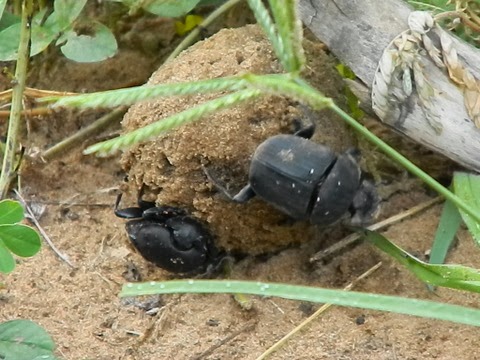The Africa Journals
Chapter 18
Creepy Crawlies
You learn not to mourn every little
thing out here, or you’d never, ever stop grieving.
—Alexandra Fuller, Cocktail Hour Under the
tree of Forgetfulness.
I wander the grounds after lunch, before the next
evening safari. In a far corner is an
unusual divider, made of suspended rocks.I also find a couple dead beetles, brightly marked, called CMR beetles. The name comes from the uniforms of the historic South Africa Cape Mounted Riflemen, a mixed-race military force in the 1800s.
Eventually, I make my way to the reptile house. I’d heard the rangers found a dead impala and put it in the reptile exhibit for the crocodiles.
I watch the crocs for a while until they drag the carcass into the water, then go inside the herpetarium, against my better judgment.
I take some photos, watch a snake shedding its skin, and leave before I cause myself nightmares.
 |
| This I thought was a beautiful combination of colors. |
 |
| This guy was scary, raising itself 18 inches straight up, looking for an escape. |
 |
| This one took offense at my presence. |
At the nearby ranger station, I find mounts of lions that had died when a fire overcame them as they crouched in a depression. The mane of the male is partially singed away.
And, then the gift shop. I also find a tee shirt with a huge dung beetle painted on the front. I didn’t buy it. I go back three times, considering it, but didn’t buy it. Dung beetles are fascinating to watch.
 | |
| These are real dung beetles, not the tee shirt. |
According to Brian, Australia imported dung beetles from many countries, including South Africa, to help control polluting problems that arose from cattle dung. While Australia had dung beetles, those insects had evolved to handle only dry dung, not moist cattle dung.
After much experimentation, many varieties of dung beetles acclimated to Australian conditions. Because the beetles bury balls of dung in the soil, their activities enrich the soil. The removal of the dung from the surface cuts down insect populations, as well as allowing the cattle to graze in areas where there had once been dung, which they would not do otherwise.
Watching a beetle less than two inches long roll elephant dung into the size of a tennis ball, and then bury it, is amazing. Equally astounding is watching the ground move as the beetle continues to work underground.
For an hilarious explanation of the dung beetle’s life, see: http://www.youtube.com/watch?v=Q1zbgd6xpGQ&noredirect=1











Why did they have a divider made of suspended rocks? I know what a divider does .. it divides .. in the above instance it prevents a human or larger animal from going through it. So? Is it just a neat and decorative divider curtain made of local rocks or is its construction significant in some way? Watching a dung beetle or several .. they seem to work as pairs .. roll up a tennis-ball sized piece of dung and then bury it and you see them working underground must be fascinating .. Smiles .. Cap and Patti .. (Patti just said that she could have missed the dung beetles had she been along on this trip!)
ReplyDeleteJust a decorative divider as far as I could tell Certainly wouldn't stop an elephant. The dung beetles do NOT work in pairs. The female does nothing to move the ball, just along for the ride. The made does all the work until it's underground. Follow the link at the post for more info.
DeleteA note to Shaddy. So happy to have you back-in-the-fold. Have you met Gullible in person? If so or If not wouldn't it be fun to meet her when up here. We will wait until you have-a-handle on your comings and goings and schedule. There is at least some chance that you will pass about 200-feet from where she lives in Moose Pass. I myself travel alone associated with no group nor organization but I do understand that when traveling in a group on a tour your life is structured.. Cheerio .. Cap and Patti ..
ReplyDeleteThat rock divider is interesting even if only as a thing to be admired. I'd like to copy it to hang somewhere in my backyard but I don't have the patience.
ReplyDeleteDo you have any idea how long that snake was that shed its skin? Its length seemed to go on and on forever.
I think you were wise not to buy the dung beetle t-shirt. (Just saying). You've promoted them admirably here on this blog post. I had no idea what was behind their name. It's awesome that you take advantage of EVERY opportunity to explore. Being single, you can do exactly what you want, without hesitation. Cool!!
That divider, as I recall, simply shielded some utility things from view. Hard to tell how long that snake was because I couldn't tell where it ended inside the old skin. Amazing video, wasn't it? I'd guess somewhere between 4 and 6 feet.
DeleteTo Cap,
ReplyDeleteI haven't met Gully in person but know her better than many people I have met. Because of our blogs, we know each other pretty darn good.
As I mentioned before and you agreed, being with a group may make it difficult to coordinate a meeting. We'll see.